Uraiyur, an ancient locality in the heart of Tiruchi Town, is situated less than a kilometer from the banks of the sacred Cauvery River. This historic area is home to one of the oldest and most revered Shiva temples in the Chola region. The temple, which dates back to the 8th century, is tucked away behind towering modern business complexes. It was constructed during the reign of the illustrious Pandiya King Varaguna Maharaja II, known for his patronage of art, architecture and religion. An inscription dated to 885 AD provides evidence of the king's devotion, as it records his donation of gold coins to the village assembly specifically earmarked for performing poojas and rituals at the temple. Further bolstering the historical significance of this temple, additional inscriptions found in the nearby Rockfort Thayumanavar Temple in Tiruchirapalli also make note of the generous endowments bestowed by the Pandiya King Varaguna Maharaja II. The Uraiyur Shiva Temple stands as a testament to the rich cultural heritage, architectural prowess, and deep spirituality that flourished under the Pandiya dynasty over a millennium ago.
kanthimadhi, the devoted wife of the Chola king who ruled from the capital city of Uraiyur, was a fervent worshipper of God Shiva. With unwavering dedication, she would make the journey to Tiruchirappalli each and every day to offer her prayers and veneration to the deity Thayumanavar enshrined there. Even after giving birth to a child, Kanthimadhi remained steadfast in her daily ritual of worship, never allowing her maternal duties to interfere with her spiritual practices. However, one fateful day, as she made her way from Uraiyur to Sirapalli under the merciless glare of the scorching sun, Kanthimadhi's strength faltered and she collapsed, overwhelmed by heat and exhaustion. Filled with profound sorrow at the interruption of her daily communion, Kanthimadhi's anguish did not go unnoticed by the divine. Moved by her distress and unwavering devotion, Shiva chose to manifest himself before her at the very spot where she had fallen. This divine appearance, born of Shiva's own will and not crafted by human hands, came to be known as Thanthondreeswarar, the one who is self-manifested.
The Uraiyur temple, also known as Kozhiyur, has a fascinating alternate history. According to legend, during the reign of the Chola king Karikal Peruvalan, the king was touring the city of Uraiyur atop his royal elephant when the elephant suddenly became overwhelmed by musth, a periodic condition characterized by highly aggressive behavior. The elephant began rampaging through the streets, causing chaos and putting the lives of the citizens in danger. Despite the best efforts of the king's soldiers to control the enraged elephant, they were unable to subdue it. In desperation, the devoted King fervently prayed to God Shiva for assistance. Hearing the king's pleas, Shiva cast his divine gaze upon a seemingly ordinary fowl on the streets of Uraiyur. Imbued with strength, the fowl took flight and fearlessly attacked the elephant, perching atop its head. Astonishingly, the diminutive fowl's assault proved too much for the mighty elephant to withstand, and it fled, eventually coming to a stop beneath a vilva tree, where the triumphant fowl also alighted. Witnessing this, King Karikalan realised that when a fowl could defeat an elephant at this place, it should have divine presence and in honor of this miraculous event, he constructed a temple at Uraiyur. The temple thus came to be known as Kozhiyur, a name referencing the fowl's pivotal role in the legend. To this day, a tangible reminder of this extraordinary history can be found in the form of a relief sculpture depicting a fowl subduing an elephant, which is carved onto the outer wall of the sanctum.

The Panchavarneswarar Temple is a marvel of architecture and sculpture. The east-facing front gate welcomes devotees into a realm of spiritual splendor. Upon passing through the stone hall, visitors are greeted by an exquisitely sculpted Nandi setting the tone for the divine experience that awaits. The temple's inner sanctums are accessed by traversing the Mahamandapam and Arthamandapam, grand halls adorned with intricate carvings and artwork depicting mythological scenes and deities. In the sanctum, the heart of the temple, resides the presiding deity in the form of a small yet powerful Shivalinga, no larger than the palm of one's hand. It is here that Shiva manifested himself to Sage Udangamuni in five resplendent forms across different times of day - as a glittering Ratna Linga in the morning light, a translucent Crystal Linga at midday, a radiant Golden Linga in the evening glow, a scintillating Diamond Linga in the depths of night, and a captivating Chitira Linga in the gentle light of mid-morning. This awe-inspiring display earned him the name Panchavarneswarar, the Lord of Five Colors. Directly opposite Panchavarneswarar's sanctum stands the sannidhi of Sage Uththanga, a testament to the profound spiritual connection between the devotee and the divine. The temple's inner hall features a remarkable sculpture on the first pillar to the left, depicting a dramatic scene where a Chola king, mounted on his royal elephant, is attacked by a fowl, a narrative steeped in legend and symbolism. In a separate sannidhi facing south, Goddess Kanthimadhi is enshrined, her hands gracefully holding an 'ankusam' and a lotus flower. Legend has it that this very idol was once worshipped by the Naga maidens in Nagaloka before being brought and installed in the temple by a Chola king. The presence of idols of Mahavishnu, Surya, Kalabhairava, and Saneeswaran in close proximity to the Goddess's sannidhi further enriches the temple's spiritual tapestry.
In the Artha Mandapam, flanking the entrance to the sanctum, stand two impressive Dwarapalakas statues, each approximately six feet tall and believed to date back to the 8th century, showcasing remarkable craftsmanship. The southern outer wall of the sanctum features a depiction of Dakshinamurthy, while the northern wall displays Brahma. Notably, there are two representations of Dakshinamurthy: a large, exquisitely sculpted figure and a smaller one from the Chola period, commissioned by the Natu Kotta Nagarathar during renovations to enhance its size. Additionally, a four-foot statue of Chandikeshwara merits attention.
The pillar opposite Tirumal Sannidhi showcases the image of Bikshadanar, while the adjacent pillar features the wives of the Rishis of Tharukavana. The Uraiyur temple is rich in sculptures, particularly on the outer wall of the sanctum, where artistic representations of various Thandavas of Shiva are arranged beautifully. Surrounding pillars also display intricate carvings, including a striking sculpture of five women arranged as a horse and another of four women in a similar formation, alongside a unique figure with an elephant's head, a human body, and bird legs. A formidable image of Kali, known as Jayakali, is prominently placed in the south side of the inner courtyard, while the sannidhi of Muruga features Muruga depicted with one face and two arms, accompanied by his two consorts.
The Thirumookeecharam temple in Uraiyur holds great significance as it represents the five elements of nature (Pancha Bhootham), paralleling the revered temples of Chidambaram, Tiruvanaikka, Tiruvannamalai, Kancheepuram, and Sri Kalahasthi. Devotees believe that worshipping the deity here brings success in new endeavors, a notion supported by the historical reverence shown by Brahma, the Creator, at this site. Additionally, the serpent Karkotakan and Garudan have honored the deity Panchavarneswar, further establishing Uraiyur as a sacred space capable of alleviating curses, sins, and 'Doshas.' The esteemed Sage Kashyapa and his wife Kathru also paid homage to the deity. Uraiyur is notable as the birthplace of the illustrious Chola king Kochengat Chola, who constructed 70 temples known as 'Mada Kovil,' designed to be inaccessible to elephants, and it is also the birthplace of Pughazh Chozha Nayanar.
Pukazh Chola, a king of Uraiyur, was renowned for his military prowess, having triumphed over rival rulers. However, his victory was overshadowed by profound sorrow upon discovering the decapitated head of a warrior, adorned with a flowing mane and resembling a devotee of Shiva, among the fallen soldiers. This sight filled him with remorse, as he believed he had wronged a 'Shivanadiyar.' In a poignant act of atonement, he appointed his son as king, ignited a fire, and chose to enter it alongside the head of the devotee, thereby achieving salvation and securing his place among the revered 63 Nayanmars.
The pathigam composed by Tirugyanasambandhar is in 2'nd Tirumurai.
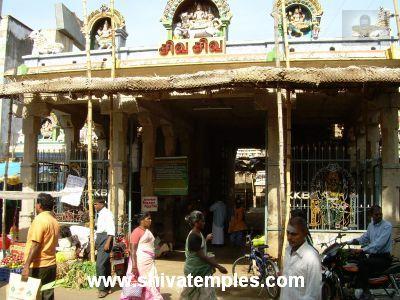 Entrance
Entrance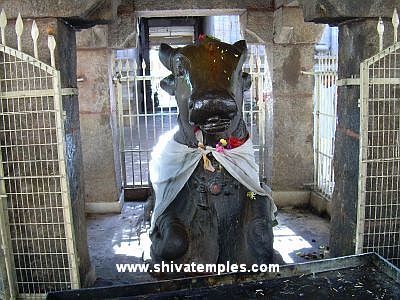 Nandhi
Nandhi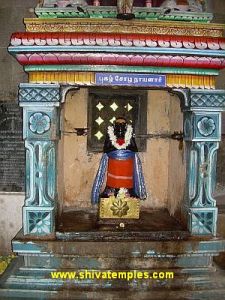 Pugazh Chola Nayanar
Pugazh Chola Nayanar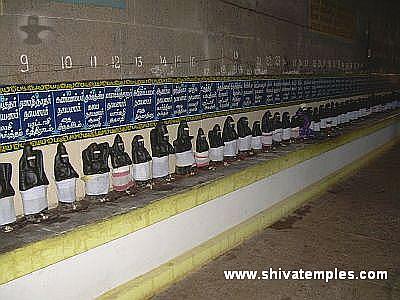 63 Nayanmars
63 Nayanmars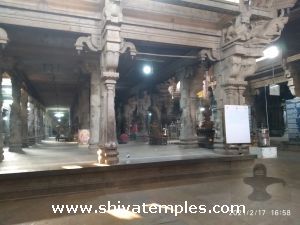 A view inside the temple
A view inside the temple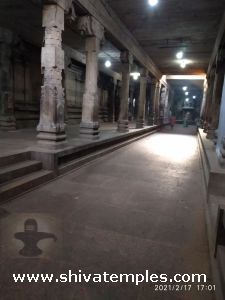 Corridor
Corridor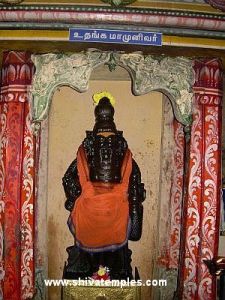 Sage Uthanga
Sage Uthanga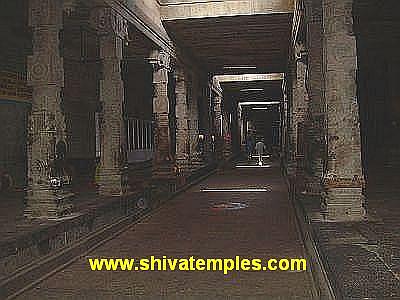 Supporting Pillars
Supporting Pillars